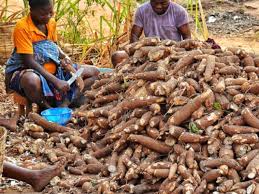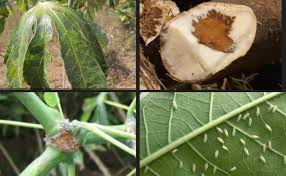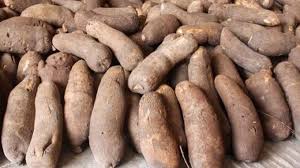Cassava, which originated in Brazil, South America, is one of the most important food crops of West Africa. It is a root tuber. It is a latex-producing plant which reaches a height of 1.8–3.6 m, depending on the variety.
Because it is easy to cultivate and will grow on poor soils, it is grown throughout West Africa. The tuber is processed into gari, tapioca and cassava flour for human consumption, while the leaves are cooked and eaten especially in Sierra Leone and Liberia.
Sweet cassava tubers can also be eaten boiled, or boiled and beaten into ‘dumboy’, as in Liberia. They can be fed raw or boiled to pigs, goats, horses and cattle. The main industrial use of cassava is the manufacture of starch and alcohol.
Climatic and Soil Requirements for Cassava Cultivation
It will grow in different climates, but gives highest yields on rich, well-drained loamy soils with a light or medium rainfall.
The tubers tend to decay in badly-drained, swampy soils, which must therefore be avoided. It requires no shade but can be adversely affected by strong winds.
Read Also: How to Grow, Use and Care for Wildrye Grass (Elymus spp.)
Cassava Varieties Commonly Grown in West Africa

Two main kinds of cassava are commonly grown in West Africa: sweet cassava (Manihot pulmata) and bitter cassava (Mutilissina). The bitter cassava contains a juice which is poisonous to humans and livestock.
This juice (called hydrocyanic acid) must be extracted before the cassava is safe to eat. Cooking is one way to do this.
The varieties of cassava differ in their stem, tuber skin, and leaf petiole colour, in the time they take to mature and in the quality of the tuber.
The commonest varieties in Nigeria are Nwangoye, which matures early but does not have a high yield; Nwaiwa, which matures late; Okotbronwa, which is tall and has a high yield; Karagba, which also has a high yield; and Dan Warri, which has been found particularly suitable for the northern states of Nigeria.
High-yielding hybrids have been developed by crossing local varieties. These are: CH50, CH125, CH28, and C779B. In 1974, the varieties recommended by the National Root Crops Research Institute, Umudike in Nigeria were 53,101 grown by farmers in western areas of Nigeria, 60,444 in the eastern areas of Nigeria, and 60,447 and 60,506 in the northern areas of Nigeria.
The four varieties give a standard high yield of 30,120–37,643 kg per hectare, but are capable of 50,198 kg per hectare. They mature in nine to twelve months instead of up to twenty-four months. They contain reduced quantities of hydrocyanic acid (HCN), hence they are much safer to eat.
They are also resistant to the cassava mosaic disease and have increased protein content (4 to 6 per cent compared with 1 per cent for other varieties).
The best varieties in Sierra Leone are Mayugbe, Two cent and Cocoa-cassava, and in Ghana are Katawia, Obwenyanka, Enyan Abasa, Katawere and Ankra Fufue.
Cassava Cultivation Practices in Nigeria and West Africa
Cassava is planted from March–October in southern areas and June–July in northern areas. Mature stem cuttings, usually 20–30 cm long are planted either in a slanting position or straight up.
Two-thirds of the cutting is buried in the soil, the rest appearing above the surface of the soil. The spacing varies from 90 cm x 90 cm to 1 m x 1 m, on ridges, mounds or on flat ground.
Longer cuttings of 60 cm give higher yields. Between 6,913–13,580 cuttings, i.e. fifty bundles are needed to plant a hectare.
Sprouting occurs after 7–14 days. The cassava tubers are ready for harvest 1–2 years later, depending on the variety of cassava, and the way the cassava is to be used.
Weeding and manuring, especially with potassium fertilizers, help to boost yield. Diuron at 3 kg ai per hectare and Pendum Fusilade are effective for controlling weeds.
Harvesting is done by hand. Each tuber is detached from the roots. Bruised or damaged tubers are thrown away. The tubers are only dug up if they will be used within two to three days, because they rot quickly.
If tubers are left too long in the soil, they become fibrous and unsuitable for eating. The major producers of cassava in Nigeria are Benue and Kogi States.
Cassava Yield and Fertilizer Recommendation
Cassava is one of the most productive crops in the world, yielding 15 tonnes of tubers per hectare on an average, and over 30 tonnes per hectare under the best growing conditions. Because of this high yield, it exhausts the soil in which it is grown.
Crop rotation as well as fertilizer application are needed to ensure that good yields are maintained. For best yields, 200 kg/ha NPK 15:15:15 and 100 kg/ha MOP (Muriate of Potash) should be applied.
Read Also: How to Grow, Use and Care for Wilman Lovegrass (Eragrostis superba)
Common Cassava Diseases in West Africa

i. Cassava Mosaic: This serious viral disease, transmitted by a whitefly (Bemisia spp), spreads rapidly. Leaves of infected plants become mottled and later, both the leaves and the stems become distorted.
The disease reduces starch formation, which affects the yield. The use of resistant varieties is helpful, although these do not yield as well as the non-resistant varieties. Healthy cuttings should be used for propagating cassava, so that the plant can withstand this disease.
Major Pests and Animal Threats to Cassava
1. Grasshoppers: Grasshoppers, especially Zonocerus variegatus, can cause serious damage to the young plants by feeding on their leaves. They can be controlled by spraying Fenithothrin or Sevin at 2 kg per hectare.
2. Animals: Serious damage to cassava tubers is caused by the cane rat, cutting grass, ground squirrel, monkeys, baboons and bush pigs. The best method of control is to trap these animals.
Yam (Dioscorea spp.): A Key Staple Tuber Crop in West Africa
Yam, a major staple in Africa, is a crop grown for its stem tubers, which is indigenous to West Africa. An estimated 48.7 million tonnes of yam were produced in 2005, with sub-Saharan Africa accounting for 97 per cent of the total production.
Yam tubers are eaten boiled, roasted, fried, mashed or pounded. Yam flour is the best form to preserve and store yams. Yams are produced in all parts of West Africa, but the area of greatest concentration of production is between Côte d’Ivoire and Cameroon.
Average daily consumption per capita is highest in Benin Republic (364 kcal), Côte d’Ivoire (342 kcal), Ghana (296 kcal) and Nigeria (258 kcal). However, in Nigeria, the major producers are Niger, Taraba, Benue and Enugu States.
1. Climatic and Soil Requirement
Yams thrive best in fertile, well-drained, loamy soils that have been properly prepared. The traditional method of cultivation involves planting on mounds of varying sizes, with each yam sett placed at the top.
If the soil is tightly packed, tuber enlargement is restricted, resulting in smaller yams. Waterlogged soils are unsuitable because they inhibit root and tuber formation and lead to rot in newly planted setts.
An annual rainfall range of 1020–1780 mm, evenly distributed, supports optimal yam growth. However, a well-defined dry season lasting two to five months is essential for proper tuber maturation and harvesting.
2. Varieties Grown
There are six commercially significant yam species cultivated in West Africa:
i. White yam (D. rotundata): It is considered the best for consumption, with large, white to cream-coloured tubers. It matures in 8 months and stores well.
ii. Yellow yam (D. cayenensis): This variety has yellow flesh and thick, heart-shaped dark green leaves. It matures in 12 months but does not store well.
iii. Water yam (D. alata): Recognised by its large leaves and petioles, this variety has large, soft, high-moisture tubers with yellow or purple flesh. It matures in 10 months and has lower storability. It is used in Nigeria to prepare ikokore and ojojo.
iv. Chinese yam (D. esculenta): This type has broad, pale heart-shaped leaves and is best suited for dry, open areas. It produces numerous small tubers per hill. These pale-yellow tubers bruise easily and do not store well. It matures in 12 months.
v. Aerial yam (D. bulbifera): This species produces tubers both above ground (on vines) and below. Its corky-skinned tubers store well, though it is not widely cultivated. Some types are edible.
vi. Three-leafed yam (D. dumetorum): It features prickly, clockwise-climbing leaves. The coarse-skinned tubers have fine-grained flesh, which may be yellow, white, or pink.
3. Cultivation
Yams are grown on mounds, ridges, or flat-surface holes, with mound bases measuring 90–150 cm wide. Mounds allow deep, loose soil for optimal tuber growth. Ridges, spaced 120 cm apart with 90–120 cm intra-row spacing, are often used in hilly areas to minimize erosion.
Big mounds use 1 m × 1 m spacing. Each sett, a yam slice weighing 95–185 g, is planted 15 cm deep at an angle to reduce water retention on the cut surface. Each sett should have at least one viable bud or eye.
Capping setts with leaves or grasses reduces soil temperature. However, continuous mulching along the ridge has proven more effective than capping individual heaps.
Though whole small tubers (seed yams) are ideal, setts can be taken from any part of the tuber provided they are of suitable size and properly cured to prevent rot.
Early yams are planted in October–November, while late crops are planted between February and April. Sett weight per hectare ranges between 2,509–5,020 kg, depending on sett size, spacing, and variety.
Sprouting begins within 20–60 days, depending on environmental conditions. Fertilizer application is discouraged during sprouting as it may damage late-sprouting setts.
4. Vine Cutting Technique
The International Institute of Tropical Agriculture (IITA) introduced yam propagation through vine cuttings using carbonized rice husks as a medium. This low-cost method offers multiple benefits:
i. Frees up tubers for food or sale
ii. Enables faster multiplication and uniform crops
iii. Reduces cost and tuber wastage
iv. Minimizes nematode risk linked to tuber use
5. Disadvantages of Using Tubers or Setts
i. 30–50% of harvested tubers are reused as seed, reducing income
ii. Low multiplication ratio (1:5–10) compared to cereals (1:300)
iii. Increased risk of nematode infestation
iv. Lower overall yield potential
6. Staking and Weed Control
Stakes are essential for supporting vines to enhance leaf exposure and yield. While some farmers leave shrubs or trees as stakes, this can result in competition for water and nutrients. Better alternatives include cassia, siamiea, or bamboo stakes about 2–2.5 m high.
In savanna areas, yams are intercropped with sorghum or maize, allowing the vines to climb the leftover stalks after cereal harvest.
Weeding is performed by hand or hoe, or chemically using Primextra herbicide at a rate of 2.5–3 kg active ingredient per hectare.
7. Harvesting
Yams mature within 8–12 months, though some may be partially harvested after 6 months to serve as seed yams. Maturity is indicated when leaves and vines dry up, and soil cracks appear near the tuber during dry weather.
Harvesting is done manually with a cutlass to avoid bruising. Early harvest takes place from July to mid-September, while the main harvest runs from mid-October to January.
8. Yield
Yam yields vary between 5–10 tonnes per hectare, depending on the variety and sett size. Larger setts typically give better yields. On fertile and well-fertilized soils with adequate rainfall, yields can reach 15–25 tonnes per hectare. The standard fertilizer recommendation is NPK 15-15-15 at 400 kg/ha.
9. Storage
Yam tubers must be kept dry, protected from direct sunlight, and elevated from the soil. After harvest, tubers are either heaped or tied onto raised racks constructed from wooden frameworks. The use of living posts for racks is ideal, as they are sturdy and sustainable.
Do you have any questions, suggestions, or contributions? If so, please feel free to use the comment box below to share your thoughts. We also encourage you to kindly share this information with others who might benefit from it. Since we can’t reach everyone at once, we truly appreciate your help in spreading the word. Thank you so much for your support and for sharing!

